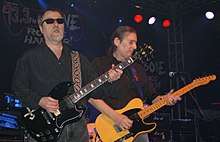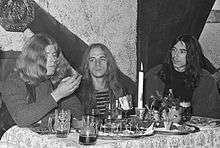Occult rock
Occult rock (also known as doom rock[1] or witch rock)[2] is a subgenre of rock music that originated in the late 1960s to early 1970s,[3] pioneered by bands such as Coven[3][4] and Black Widow.[3] The genre is influenced by hard rock, proto-metal, psychedelic rock, progressive rock and blues, as well as commonly incorporating lyrics referencing the occult. Despite the common perception, it has been noted that occult rock is not inherently gloomy nor dark, however many bands have ventured down that path.
| Occult rock | |
|---|---|
| Stylistic origins | |
| Cultural origins | Late 1960s to early 1970s, England and United States |
| Typical instruments | Vocals, guitar, bass, drums |
| Derivative forms |
|
| Other topics | |
Characteristics
The genre has been described as being influenced by hard rock,[5] proto-metal,[6] psychedelic rock,[1] progressive rock[7] and blues,[8] as well as commonly incorporating lyrics referencing the occult,[3] however is not inherently gloomy nor dark.[7] AXS noted that Tony Iommi's doom rock style of riffing defined the genre of heavy metal.[9]
History

Origins (1960s–1990s)

Occult rock emerged in the 1960s with groups such as Jacula, Black Widow[3] and, most notably, Coven.[4][10] Iron Butterfly's 1968 track "In-A-Gadda-Da-Vida" was very influential to the development of occult rock's sound.[11] Coven released their debut album Witchcraft Destroys Minds & Reaps Souls in 1969, which preceded later occult rock groups such as the debut album by Black Widow, titled Sacrifice.[3][12] Blue Öyster Cult released their debut album Blue Öyster Cult in 1972,[13] which had significant influence on later bands such as Ghost.[14] Due to the association with the occult, around the time of the Manson Family murders, many occult rock albums were halted from distribution, which only helped increase the public's fear of the music.[15][16][17] When Black Sabbath first released their eponymous debut album in 1970, Rolling Stone's Lester Bangs described it as "England's answer to Coven".[18] Early occult rock bands such as Coven, Black Sabbath, Blue Cheer, Hawkwind and Blue Öyster Cult are considered by some critics to be extremely influential on the development of heavy metal music,[19][20][21][22] or more specifically, styles such as stoner metal, doom metal and sludge metal.[23][24][25] In article for the BBC, John Doran described Judas Priest's British Steel as the missing link between the doom rock of Black Sabbath and extreme metal styles, like thrash metal, death metal and black metal.[26] In 1976, Blue Öyster Cult released their fourth studio album Agents of Fortune; the album's first released single, "(Don't Fear) The Reaper", peaked at number 12 on the Billboard Hot 100 chart.[27][28] The imagery of occult rock bands was eventually revived, with the rise of New wave of British heavy metal bands such as Venom, Satan and Hell.[29]
Revival (2000s–present)
Beginning in the 2000s, occult rock experienced a revival, with a sound reminiscent of the style of the 1970s, including bands such as Ghost, Luciferian Light Orchestra, The Devil's Blood, Witch Mountain, Orchid and Blood Ceremony.[30][31] Ghost's third and fourth albums reached numbers 8 and 3, respectively, on the Billboard 200. In 2007, occult rock bands Coven and Black Widow reformed and toured with many bands that they helped influence.[31] Prog Magazine described the revival as encompassing a myriad of styles, including post-rock, psych-prog and progressive rock, as well as a distinct number of bands possessing female vocalists.[7] Kadavar are considered by some critics to be one of the bands spearheading the German occult rock scene, despite them rejecting the label themselves.[32] Kadavar's third studio album "Berlin" reached number 21 on the Billboard Heatseekers albums charts in 2015,[33] which was five places higher than their previous effort.[34]
See also
References
- Kim, Grim. "INTO THE COVEN: WOMEN OF OCCULT ROCK". Retrieved 16 June 2018.
- Alisoglu, Scott. "BLOOD CEREMONY 'Blood Ceremony'". Blabbermouth. Retrieved 17 June 2018.
- Lawson, Dom. "Occult rock: do you believe in black magic?". The Guardian. Retrieved 16 June 2018.
- TK, Levan. "Occult Rock Pioneers Coven Hold Unholy Mass at the Regent". LA Weekly. Retrieved 16 June 2018.
- Malone, Nick. "DENIM AND LEATHER – JULY – OCCULT ROCK RESURGENCE". Lodown magazine. Archived from the original on 19 June 2018. Retrieved 16 June 2018.
- "LUCIFER: SET TO RELEASE NEW ALBUM 'LUCIFER I' VIA RISE ABOVE RECORDS". Retrieved 17 June 2018.
- Lloyd-Davis, Isere. "Paperlate: the modern witch goes prog". Prog. Retrieved 17 June 2018.
- "LUCIFER To Release Debut Album in June". Blabbermouth. Retrieved 17 June 2018.
- Todd, Nathan. "Black Sabbath's Tony Iommi: 10 guitar riffs that almost never were". AXS. Retrieved 19 June 2018.
- Selzer, Jonathan. "Occult rock pioneers Coven return: "We thought people were going to kill us!"". Metal Hammer. Retrieved 17 June 2018.
- Horror Revival, Folk. Folk Horror Revival: Harvest Hymns. Volume I- Twisted Roots. p. 55.
- Viglione, Joe. "Coven Witchcraft Destroys Minds & Reaps Souls". AllMusic. Retrieved 18 June 2018.
- Jurek, Thom. "Blue Öyster Cult Blue Öyster Cult". AllMusic. Retrieved 18 June 2018.
- Bliss, Tony. "Opinion: Buzz Bands, Satanic Pomposity and Why Ghost are Good for the Metal Scene". Retrieved 18 June 2018.
- Kendrick, Monika. "Occult-rock legends Coven will destroy minds and reap souls on Halloween". Chicago Reader. Retrieved 17 June 2018.
- Norton, Justin. "Q&A: Jinx Dawson on the Return of Coven and Spirituality in a Dogmatic Age". Decibel. Retrieved 17 June 2018.
- Ludwig, James. "Shocking Omissions: Coven's 'Witchcraft Destroys Minds & Reaps Souls'". NPR. Retrieved 17 June 2018.
- Bangs, Lester. "Black Sabbath: Black Sabbath". Rolling Stone. Retrieved 17 June 2018.
- Heigl, Alex. "The Overwhelming (and Overlooked) Darkness of Jinx Dawson and Coven". People. Retrieved 17 June 2018.
- Tom Larson (2004). History of Rock and Roll. Kendall/Hunt Pub. pp. 183–187. ISBN 978-0-7872-9969-9.
- Fricke, David. "Where Are They Now: Blue Cheer". Rolling Stone. Retrieved 17 June 2018.
- Wolfe, Paul. "Blue Öyster Cult: Heavy metal legends". AXS. Retrieved 17 June 2018.
- "Black Sabbath: Iron Men". Archived from the original on 13 June 2017. Retrieved 17 June 2018.
- "Stoner Metal". AllMusic. Retrieved 17 June 2018.
- "Doom Metal". AllMusic. Retrieved 17 June 2018.
- Doran, John. "An essential heavy metal artefact given the deluxe anniversary treatment". BBC. Retrieved 18 June 2018.
- Jurek, Thom. "Blue Öyster Cult Agents of Fortune". AllMusic. Retrieved 18 June 2018.
- "Blue Öyster Cult". Billboard. Retrieved 18 June 2018.
- Horror Revival, Folk. Folk Horror Revival: Harvest Hymns. Volume I- Twisted Roots. p. 59.
- Patridge, Christopher. The Bloomsbury Handbook of Religion and Popular Music. Bloomsbury Publishing.
- "JESS AND THE ANCIENT ONES – THE HORSE AND OTHER WEIRD TALES". Retrieved 17 June 2018.
- Moore, Anthony. "Kadavar Reveal New Album Artwork & Track Listing". Retrieved 20 June 2018.
- "Berlin Kadavar". Billboard. Retrieved 19 June 2018.
- "Abra Kadavar Kadavar". Billboard. Retrieved 19 June 2018.